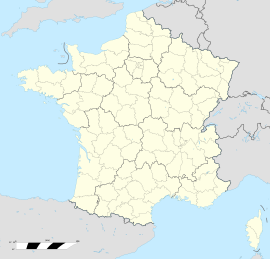Nantes
city in Loire-Atlantique, Pays de la Loire, France
Nantes is a city in France, the prefecture of the Pays de la Loire region and the Loire-Atlantique department, on the Atlantic Ocean. From the 16th to the 19th centuries, it was the busiest slave trading port in France.[1] Before 1941, Nantes was part of Brittany. The Gallo and Breton languages are spoken in the city. Jules Verne was a famous writer from Nantes.
Nantes | |
|---|---|
Prefecture and commune | |
Top to bottom, left to right: the Loire in central Nantes; the Castle of the Dukes of Brittany; the Pommeraye Arcade, and the Isle of Nantes between the branches of the Loire | |
| Motto(s): | |
| Coordinates: 47°13′05″N 1°33′10″W / 47.2181°N 1.5528°W | |
| Country | France |
| Region | Pays de la Loire |
| Department | Loire-Atlantique |
| Arrondissement | Nantes |
| Canton | 7 cantons |
| Intercommunality | Nantes Métropole |
| Government | |
| • Mayor (2014–2020) | Johanna Rolland (PS) |
| Area 1 | 65.19 km2 (25.17 sq mi) |
| • Urban (2008) | 537.70 km2 (207.61 sq mi) |
| • Metro (2013) | 3,302 km2 (1,275 sq mi) |
| Population (2016 census) | 298,029 |
| • Rank | 6th in France |
| • Density | 4,600/km2 (12,000/sq mi) |
| • Urban (2013) | 612,782 |
| • Urban density | 1,100/km2 (3,000/sq mi) |
| • Metro (2013) | 908,815 |
| • Metro density | 280/km2 (710/sq mi) |
| Time zone | UTC+01:00 (CET) |
| • Summer (DST) | UTC+02:00 (CEST) |
| INSEE/Postal code | 44109 /44000, 44100, 44200 and 44300 |
| Dialling codes | 02 |
| Website | nantes.fr |
| 1 French Land Register data, which excludes lakes, ponds, glaciers > 1 km2 (0.386 sq mi or 247 acres) and river estuaries. | |
Nantes has an oceanic climate (Cfb in the Koeppen climate classification).
Education
changeTwin towns
changeNantes has town twinning and cooperation agreements with:
|
|
Friendship relations
changeThe city has friendship relations with:
- Guinea, since 1992.
- St. Martinville, Louisiana, U.S., since 1993.
- Jericho, West Bank, since 2001.
- Desdunes and Petionville, Haiti, since 2005.
- Nantes, Quebec, Canada, since 2009.
Gallery
change-
Port -
Another view of the cathedral -
Feydeau island -
La Marie Séraphique, a slave ship that traveled from Nantes
References
change- ↑ Tibbles, Anthony (2000). "Ports of the Transatlantic slave trade". National Museums Liverpool. Retrieved 2020-11-08.
Again in France we can come up with a list of nearly 20 ports which were involved with the trade at some point but there were four principal slaving ports: Nantes, Bordeaux, La Rochelle and Le Havre. Over the period, Nantes sent 45% of all the ships in the French trade the other three sending 11% of the trade each and the rest shared between the other ports.
Other websites
changeWikimedia Commons has media related to Nantes.








